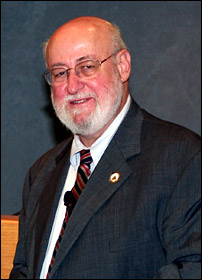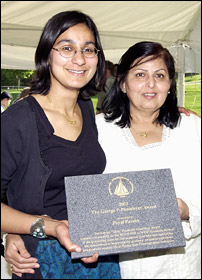
|
 |
Academic Programs > Report
from the Vice President for Academic Programs & Dean
Report from the Vice President for Academic
Programs & Dean
 |
 |
John Farrington, Vice President for Academic Programs & Dean. (Photo by Tom Kleindinst)
|
 |
| Payal Parekh,
left (with her mother Meena Parekh), received the George
P. “Gera” Panteleyev Award, which recognizes the graduating
student who exemplifies a commitment to improving the
graduate educational experience and student life at WHOI.
The award honors the memory of Gera Panteleyev, a Joint
Program student who died during a research expedition
in Russia in 1995. The recipient is selected by the Joint
Program students. Payal received a doctoral degree in
chemical oceanography in 2003. (Photo by Tom Kleindinst) |
The interweaving of research, teaching, advising,
and mentoring has been at the heart of the Institution’s learning environment since its founding in 1930. This culture and practice was carried forward formally with the inauguration of a graduate education program in 1968. By 2003, the 35th year of the MIT/WHOI Joint Program in Oceanography and Applied Ocean Science and Engineering, more than 600 degrees had been granted
through this unique joint degree program. Our alumni and alumnae continue to rise to leadership positions in ocean science and ocean engineering worldwide, advancing knowledge of the oceans and applications of that knowledge in the academic, government,
business, and nonprofit sectors. The 134 students enrolled in 2003 are following in the excellent
tradition of their predecessors.
Our postdoctoral program has continued to attract
the highest caliber recent doctoral degree recipients.
We have reorganized our postdoctoral advising and support structure to provide the high-quality WHOI postdoctoral experience
for nearly three times the number of postdocs in residence at WHOI, compared to the mid-1990s, due to increased internal and external fellowship support. The postdoctoral program continues to be an important recruiting mechanism for WHOI scientific
and technical staff. Four of the five new assistant
scientists who took up their appointments this year came from the postdoctoral ranks of WHOI.
Our undergraduate offering, a summer program of research experience
and introduction to Academic Programs ocean science and ocean
engineering, continues to attract a high number of competitive
applications nationwide. Thirty undergraduate summer student
fellows and minority fellows took part in the program this year,
representing 29 educational institutions (see Summer
Student Fellowship Program). We are cooperating with our
neighbor institutions in Woods Hole—the Marine Biological Laboratory,
the National Marine Fisheries Service, the United States Geological
Survey, and the Sea Education Association—to recruit and retain
greater numbers of students from underrepresented groups into
ocean science and ocean engineering.
Our fall and spring workshops for K-12 teachers
are enthusiastically received and provide an effective forum for connecting K-12 educators with the latest research. These workshops complement
our efforts in various areas of distance learning
on the Web. In 2003, we completed the first full year of a five-year grant from the National Science Foundation to establish the New England Center of Ocean Science Education Excellence (NE-COSEE), a partnership of WHOI, the New England Aquarium, and the University of Massachusetts. The COSEE is finding and evaluating
ways to link ocean researchers with educators, students, and the public across the region, and assisting
researchers with tools, techniques, and opportunities
for outreach.
While our primary focus is on higher education, the Institution’s education efforts appropriately span the life-long learning experience—sometimes referred to as “K to gray.” As one of the “gray” folks, I enjoy immensely my continuing education—learning
from the students, postdocs, and colleagues of our WHOI Academic Programs.
—John Farrington (jfarrington@whoi.edu)
Vice President for Academic Programs & Dean
|
|
